Tourism in Guizhou, one of the last areas mostly undiscovered by the outside world, has started to take flight. With big media names such as CNN and BBC travel covering Reasons to visit Guizhou or rural tribes untouched by modern society, this hidden province in southern China is trying to make a distinct name in the industry. As cities like Beijing, Xi’an and Shanghai still are the faces of China for commercial tourism, lesser known places such as Guizhou now try to change that image. Before I ever been to China – even as a kid – I always had this image of China having the most incredible natural scenery with green seas of bamboo (with baby panda’s playing inside of course), the grandest mountains and most otherworldly green karst hills. And boy, was I right! (except for the baby panda’s, haven’t seen those in the wild, yet…). Now I’m working for Wonders of Yunnan Travel and Amazing Guizhou and I get many great opportunities to explore these wonders of nature by myself, the last one being the one of the biggest cave systems in the world. South China’s caves are so remarkable, that National Geographic wrote several items on them and posted a video article about the Shuanghe Caves that we were about to visit in a promotional trip organized by the scenic area.
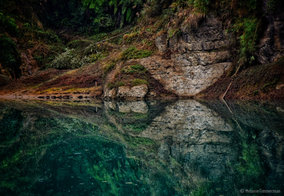
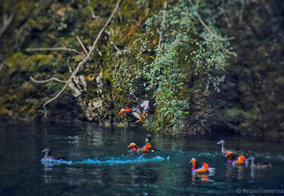
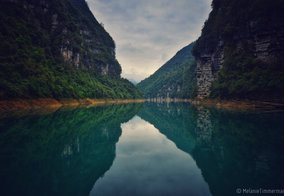
Friday January 18, fresh into the year 2019, we took off early by high-speed train from our blue-skied Kunming onto the north of her neighbor Guizhou. The train trip itself is a lust for the eyes, passing villages spread between the typical karst hills, embraced by twirling mist clouds that give the scenery a mystical atmosphere. We were picked up from Zunyi train station by our welcoming driver who would take us in 2 hours to our destination. We already would miss the first activity that started at 2 o’clock, a visit to Dadifeng (大地缝), or “Earth Fissure”, marketed as photographically not much different from the famous Antelope Canyon in Arizona (remember that wallpaper in Windows 7?). In the later afternoon, a visit to the main attraction of the area was planned, a visit to the Shuanghe or “Double River” cave (双河洞). Unfortunately, we bumped into a construction on the road which caused us to be stuck in a traffic jam for at least one hour, thus missing both these attractions. This was a big shame, since on Saturday there was only one more attraction planned.
When we finally arrived at our destination, a scenic area called Shi’er beihou “十二背后”, which can be translated as “behind the back of twelve”. The staff at the scenic area explained us why it is called 十二背后. In Chinese, “十二” means twelve, but if you merge the character “十” (ten) together with “二” (two) as one character, it will become the character “王” (King). “背后”, meaning at the back, comes from the fact that the area is hidden and unknown. And thus, the true meaning of the name is “A hidden kingdom of landscapes”. In lack of an official English name, I will hereby call it “the Twelve Backlands”.
Once we continued deeper into the Twelve Backlands, a huge area covering over 600 km2, we approached a cozy valley with orange lights dancing around wooden cottages like little flames, reflected on mirror-like pools and streams, spread between the misty mountains and jade trees. Still in awe of this sight, we were wondering if that would be where we would stay. And indeed, it was. We got a warm welcome from the hotel and scenic area staff .
Shuanghe Guesthouse
The rooms were spacious with a rustic European style, wooden beams and cast-iron chandeliers with candles (fake ones of course, this is the 21st century after all) from the wooden ceilings. A comfortable sitting area was at the back of the rooms, surrounded by glass walls with views over the mountains. There were a lot of details that we liked, like the robust leather couch and elegant Renaissance style chairs, the copper shower and the detailed colorful cupboards. The air-conditioning was great, heating up the cold room within minutes despite the size of the room
The dining hall looked like a big throne room with glass walls and wooden pillars and beams, including huge castle-style cast iron chandeliers. I loved the look of it, and best of all, it was nice and warm inside. The food was good with a decent choice of Chinese dishes. Breakfast was good, they had rice noodles and other typical Chinese breakfast items, but nothing super special. As for western food, there was just some toast with butter and jam, boiled eggs and coffee and milk.
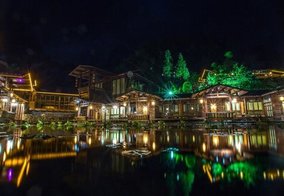
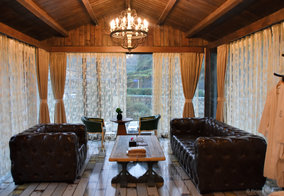
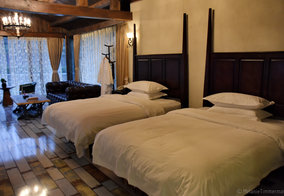
Cave-tent Hotel
Saturday morning after breakfast we first visited a cave that they want to turn into a bar and tent hotel. The cave was nice, the bar at the cave entrance could be nice though. There was a big screen for watching movies too.
Qingxi Gorge boat trip
Afterwards we continued to the main attraction of that day, a boat trip on the Qingxi Gorge. It was about 2 hours’ drive from our hotel. It was pretty, but it didn’t look much special from the port. Luckily our boat had a deck on top of the sitting area and it is where I spent the whole trip. It was a bit cold, but as the trip continued, the green hills turned emerald and the water deep turquoise. On camera, the colors turned out to be even more bright and the river was a polished image of the the rough hills of the world above. A fun part of the trip was, armed with my camera, trying to shoot the vibrant water birds that inhabit the gorge in their flight. Unfortunately, my equipment isn’t super professional, but for the well-armed photographers, this place is a paradise.
After this trip we had lunch in a hotel next to the gorge, the Qingxi Gorge Color Hotel. The lunch was actually quite good with a lot of choice. The hotel looked nice, but we didn’t have time to check out their rooms.
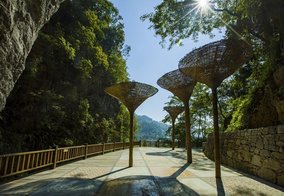
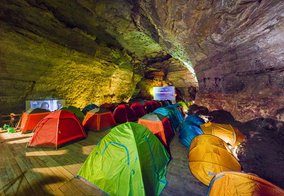

Milky Way Cave Excursion
And that morning definitely made up for the visits we missed on Friday. Instead of visiting the Shuanghe cave, they agreed to take us caving to the Yinhe cave, or Milky Way cave. I didn’t know what to expect, I thought we would just enter a cave, look around and that would be it. But that morning me and my colleague were received by two handsome young men wearing fitted red coveralls and orange helmets. After a short briefing, we got or provision bag with a simple sweet bread, energy bar and small bottle of water. We got into our provided gear; We were going caving and we finally got to ride one of the fancy classic car style golf carts.
The expeditions to the Shuanghe Cave Network started in 1987 and since then at least 20 expeditions have been done by Chinese and international teams from France, Japan, Canada and Portugal. The well-renowned French caver Jean Bottazzi has taken the lead now for the expeditions to this huge cave network, that was named longest cave in Asia and 6th longest cave in the world last year March. 238.48 kilometers have now been explored, a total of 200 different entrances and 8 main caves.
We were of course only going to see a tiny part of it, and as our coach explained, we would only cover 10km this morning. Our coaches Xiaoming and Liu Yongming are part of the expedition team, but also regularly arrange these excursions for tourists to share the marvels of the area with the rest of the world. We were dropped off in a quiet hamlet at the foot of the impressive cave exit we could see from a distance. We would enter the cave from another entrance and had to walk about 15 minutes. As we arrived at the wide entrance in the mountain covered in a carpet of fresh lime-green vegetation, I regretted not having brought my camera, as they told us not to bring big camera equipment for safety. In hindsight bringing a SLR camera with normal sized lens would definitely be alright if you are just careful not to hit it against the rocks (still your own risk).
We got into our safety harness and got an explanation how to use the carbines and descenders to abseil off vertical rocks. Just at the entrance there was an opportunity to try it out safely above the ground before doing it for real.And thus, we entered into the deep.
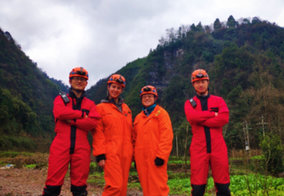
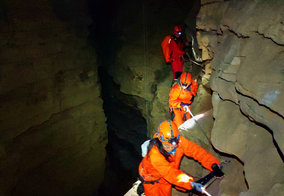
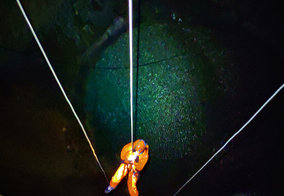
Right at the entrance there was a deep cliff, but instead of abseiling down, we hooked ourselves to the ropes on the cave walls and continued crawling on the side of the cliff, with a river about ten meters below and the ceiling who knows how far above us. We zig-zagged along the cliff until we got down to the river bed where we unhooked ourselves and continued our way. We passed clear pools of azure water and even met some wild life, bats and crickets. But then came our first abseil! I was very excited as it was something I originally didn’t expect to be doing that day. But the coached said they even had kids do it. It was a lot of fun, abseiling like this, jumping against the vertical walls. The second abseil would be 20 meters and just above the deepest pool we would encounter. And turned out, it would be away from the walls. The moment Xiaoming locked me safely onto the ropes coming down from out of nowhere above us and told me to let go was quite thrilling. You are now completely dependent on the descender-device with a plastic handle. But don’t overthink it, because they do this daily and the equipment is all secure and professional. After that one second of adrenaline rush, I actually enjoyed floating in the air and slowly descending down towards the bottom where Liu Yongming was waiting for us. Arriving safely on land again, I was kinda disappointed this was the last abseil we would do. After taking in the beautiful view of the azure pool, the four of us took a moment to take in the spirit of the cave in her natural environment: in the dark.
After a total of maybe 2 to 3 hours there was light at the end of the tunnel and it was like being reborn into the world as we exited the cave into the rays of sun falling onto fresh ferns, moss-covered rocks and stone-age Era like bamboo shelters surrounding a shimmering pool of water with the earth’s ceiling towering far above us. I couldn’t get myself to leave.
The whole cave excursion was a whole new experience for me, but I felt completely in my element. This kind of adventure is what I am made to do, and clinging along cliffs and hopping down rocks came natural for me. This excursion definitely made the whole trip worth it.We left with a feeling we didn’t get to see enough of this area, that as a huge potential for foreign travelers as well.
With a stunning green environment, friendly and helpful staff and a promising future for adventure sports like caving in one of the world’s longest caves and bungee-jumping in an UNESCO karst-area for an affordable price, this area will doubtless help Guizhou change the face of China as an international travel destination.
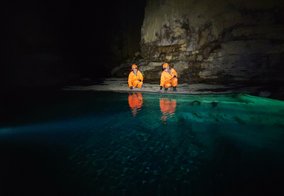
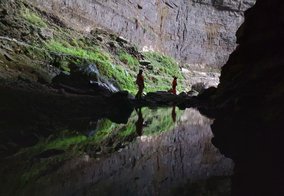
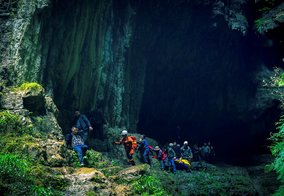
If I piqued your curiosity, here is some practical information how to get to the area:
There are 4 ways to get there: by air, high-speed train, car or bus.
First way, by air, there are 2 airports in Zunyi prefecture: Xinzhou Airport and Maotai Airport. If you want to visit Twelve Backlands, Xinzhou Airport is the one you are looking for, about 70 km from the scenic area. The second way is to take a brand new high speed train to Zunyi station. Then the fastest and most convenient way is to take a Didi taxi to the scenic area (we spent abut 280 yuan one way). If you are not too far away from Zunyi, or if you just love road-trips like me, you can also choose to drive there yourself by car. It will take about 3-4 hours from Chongqing via the Nandao expressway and 4-5 hours from Guiyang via the Guizun expressway. If you’re on a budget, then you can take a bus from Guiyang Jinyang bus station to Zunyi bus station and then transfer to a bus provided by the scenic area to your destination (20 yuan one way).
- 163 reads
- Like this







